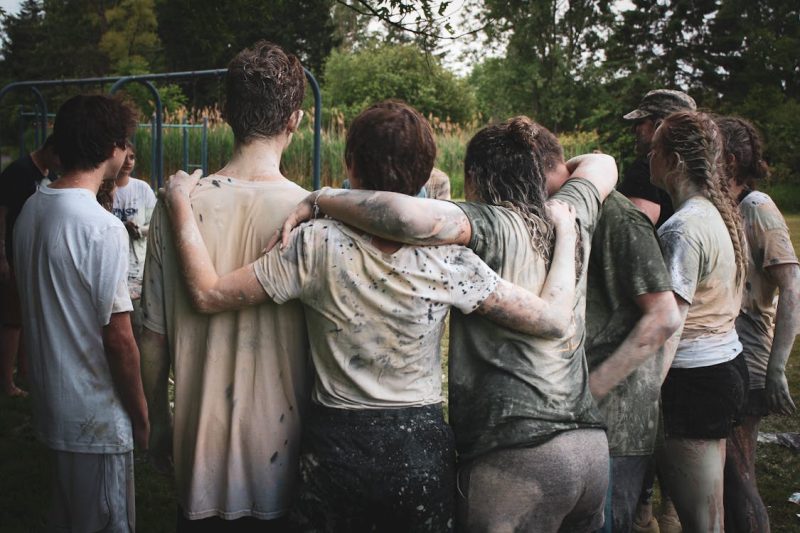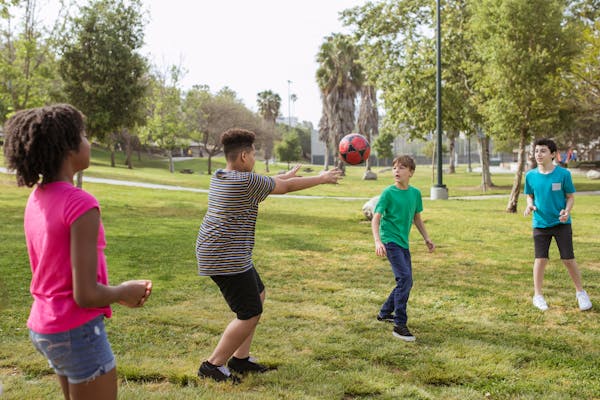
Some of the best recreational games for teens have been introduced previously. Instead, they are combinations or variations of old favorites. These can be great ways to get teens off the couch and encourage them to exercise, take a break from video games, text, and interact with humans.
The Importance of Outdoor Activities:
The allure of screens presents stiff competition for outdoor activities, making them less appealing to our teenagers and preteens. However, with some encouragement, older kids can discover the myriad of exciting outdoor pursuits. From unique suggestions tailored for teens to activities suitable for children of all ages, read on to unlock a world of adventure and appreciation for the great outdoors.
Teenagers must spend time outdoors, as it greatly benefits their mental health. In today’s digital age, many kids and teens are becoming increasingly disconnected from nature, spending excessive time indoors. However, even a simple outdoor activity like taking a walk can significantly reduce stress and anxiety, serving as an essential mental health strategy for adolescents to learn. While “Wilderness Therapy” and “Forest Bathing” have emerged as effective methods to help troubled teens and adolescents improve their self-esteem, engaging in fun outdoor activities can provide anyone with a rejuvenating “feel-good” experience.
Outdoor adventures not only promote confidence but also help children develop resilience. With more children spending time indoors than ever, ensuring they have opportunities to explore the outdoors and engage in stimulating activities is essential. If you’re seeking ways to encourage older children to step away from computer screens and embrace the outdoors, here’s a comprehensive list of exciting outdoor activities tailored for teens!
Increasing the level of challenge in outdoor adventures is critical for older kids. Teenagers thrive on problem-solving, challenges, and teamwork, which can be effectively fostered in the great outdoors. While activities like camping, canoeing, rock climbing, roller skating, mountain biking, and BMXing are perfect for engaging teens, they don’t necessarily have to be expensive. Sometimes, simply challenging a teen or tween to conquer a small mountain can be enough to ignite their enthusiasm for outdoor exploration!
The 7 Best Recreational Games for Teens:
Frisbee Croquet
Frisbee Croquet is one of those recreational games for teens that solves the drawbacks of two activities: Frisbee golf and croquet. Croquet has seen its glory days, but most teens today consider it old-fashioned. Because so many croquet sets in circulation have been sitting in garages for decades, most croquet sets still need parts. Meanwhile, Frisbee golf remains highly popular. The problem is it’s hard to find a spot to play it since, on weekends, very accomplished players and leagues take over Frisbee golf courses.
To play Frisbee croquet, set up the equipment like you would for a regular game. If you are missing some of the brackets, don’t worry. You can use as many or as few brackets as you want. Instead of using the mallet to propel the croquet ball through the brackets, players throw their Frisbees towards the brackets.
Like traditional golf, players take turns throwing their Frisbees, ensuring each throw makes contact with the bracket before progressing to the next one. The first person to hit the last bracket wins that game. If you want to play longer, consider each trip around the brackets a round and decide beforehand how many rounds you will complete.
Superball Basketball
You can play this game with the same rules as basketball, but instead of a regulation basketball, you use one of those tiny, bouncy balls you can buy from a gumball machine in the supermarket. To make the game less challenging, substitute a bounce and catch for dribbling or omit the dribbling completely. If you remove the dribbling requirement, you can rule that players with the ball can only take two steps in any direction. This keeps one player from holding onto the ball the entire time since they can only get close to the basket with teamwork.
You’ll want to play this game half-court because the full-court will result in chaos with very long passes, which are likely to go awry. Only start a game with a few other balls available since these are easy to lose. If the teens get bored, you can even add a second ball into the game. The only rule you need to add is that if one ball goes out of play, the other ball is deemed out of play and is reintroduced into the game using the players who last touched it.
For added enjoyment, consider filming the game from approximately 20 yards. The video camera won’t catch the ball and will look like the players are playing without one.

Water Balloon Baseball
Teenagers will play with water balloons whether or not you want them to. It can be a form of self-defense to get them involved in an organized activity rather than horseplay that ends with a random balloon fight in the house.
Teens can play water balloon baseball with the same rules as regular baseball except for the following:
- The game doesn’t use a pitcher. Instead, the batter starts by throwing the balloon.
- Anytime a balloon breaks, the last person to touch it has to run to where more water balloons are kept (in a bucket where the pitcher’s mound would be), grab another balloon, and continue play.
Balloons should never be thrown at another player’s head to avoid injuries. If a thrown water balloon hits the head of a player, this results in the thrower’s team being given one out or stripped of one out; the reintroduction process depends on whether the players are fielding or hitting at the moment.
For safety’s sake, filling the balloons quite thoroughly is essential. It might seem counterintuitive, but an enormous balloon will break more easily. If a teen throws the balloon with great force, it will break instead of bouncing off and leaving a bruise or worse.
Foraging
Kids have an innate curiosity for exploration, often reveling in the excitement of outdoor scavenger hunts. Why not embark on a foraging adventure with your teenager? It’s a refreshing outdoor activity to experience together! Begin your foraging journey by exploring reputable websites that guide safe foraging practices and necessary precautions.
Foragers explore and collect food from the wild, such as greens, fruits, mushrooms, seeds, nuts, and herbs. We rely on our keen instincts and acquired knowledge to identify edible plants and avoid poisonous ones safely.
The Floor is Lava
“Lava Floor” is a versatile game that can be played indoors or outdoors, accommodating larger groups with whatever materials are available. The objective is for teams to traverse from one side to the other without touching the ground (or “lava”). Players must utilize the provided supplies and collaborate to strategize the best route. Whether it’s cardboard, hula hoops, wooden planks, old towels, packaging, rope, or bean bags, participants must creatively use whatever items are at their disposal to navigate from Side A to Side B successfully.
The essence of this game revolves around finding solutions to the challenge posed by the lava. It’s common for people not to discover the optimal solution on their first attempt when problem-solving. Did anyone experiment with an idea that didn’t prove successful? Conversely, what ideas proved effective? Encourage everyone to discuss their thoughts with the person next to them and share their insights with the group. Congratulations to all who participated and demonstrated teamwork by giving it a try!
Lamp Chicane
Lamp Chicane is an exciting game best played at night. It involves two teams with participants of all ages, and you’ll need several camping lanterns or bright lights to set up. Begin by placing two lanterns approximately 100 meters apart as home bases. Then, position two more lanterns about 40 meters apart, perpendicular to the first pair and halfway between them. Depending on the number of players and the size of your playing area, you can add more lanterns as desired.
One team divides into two groups, each half heading to one of the home base lanterns. Consider using markers, such as colored ties or sashes, to distinguish “catchers.” Only the designated markers are allowed to catch other players. The game’s objective is for players to reach the opposing team’s home base lantern without being seen. They must navigate between the two intermediate lanterns to reach their destination. While there’s no limit to how far they can stray to either side, they must pass between the two lanterns that are 40 meters apart. Each team earns a point for every member who successfully reaches the other team’s home base lantern.

Obstacle Courses
Like relay races, obstacle courses can add a delightful twist to outdoor activities, accommodating small and large teams. You can easily construct an obstacle course using items found in your garden, making it a versatile and engaging option. For an added layer of excitement, consider setting up the course in a wooded area, incorporating elements like stacked logs to jump over or weaving around trees.
Whether you’re aiming for an elaborate course reminiscent of the Olympic Games or a simple setup, there are plenty of options to explore. Ideal obstacles include climbing nets, hula hoops, and chairs to navigate around or under. Use a rope to clarify the course’s starting and ending points.
Safety:
Safety is paramount in all activities and must be meticulously managed. Perform a thorough risk assessment and implement measures to mitigate potential hazards. Utilize the safety checklist to aid in planning and assessing the risks associated with your activity. Ensure the activity receives approval and that appropriate supervision and an InTouch process are provided.
For active games, ensure that the game area is hazard-free. Clearly articulate the game’s rules and establish a method for promptly halting the game when necessary. Refer to our guidelines for safely organizing active games.
Conclusion:
Engaging in recreational games offers teens an excellent chance to enjoy the advantages of physical activity without the intense competition often associated with varsity or league sports. Most teens also find trying something out of their comfort zone fun.













